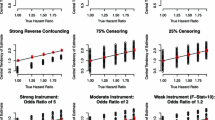Abstract
We consider methods for estimating causal effects of treatments when treatment assignment is unconfounded with outcomes conditional on a possibly large set of covariates. Robins and Rotnitzky (1995) suggested combining regression adjustment with weighting based on the propensity score (Rosenbaum and Rubin, 1983). We adopt this approach, allowing for a flexible specification of both the propensity score and the regression function. We apply these methods to data on the effects of right heart catheterization (RHC) studied in Connors et al (1996), and we find that our estimator gives stable estimates over a wide range of values for the two parameters governing the selection of variables.
Similar content being viewed by others
References
A. Abadie and G. Imbens, “Simple and bias-corrected matching estimators for average treatment effects,” unpublished manuscript, Department of Economics, UC Berkeley, 2001.
A. F. Connors, et al., “The effectiveness of right heart catheterization in the initial care of critically ill patients,” Jornal of the American Medical Association, 276, pp. 889-897, 2001.
J. Hahn, “On the role of the propensity score in efficient semiparametric estimation of average treatment effects,” Econometrica, 66, pp. 315-331, 1998.
J. Heckman, H. Ichimura and P. Todd, “Matching as an econometric evaluation estimator: evidence from evaluating a job training program,” Review of Economic Studies, 64, pp. 605-654, 1997.
J. Heckman, H. Ichimura and P. Todd, “Matching as an econometric evaluation estimator,” Review of Economic Studies, 65, pp. 261-294, 1998.
K. Hirano, G. Imbens and G. Ridder, “Efficient estimation of average treatment effects using the estimated propensity score,” NBER Technical Working Paper 251, 2000.
D. Horvitz and D. Thompson, “A generalization of sampling without replacement from a finite population,” Journal of the American Statistical Association, 47, pp. 663-685, 1952.
A. Miller, Subset Selection in Regression, Chapman and Hall, London, 1990.
D. J. Murphy and L. E. Cluff, “SUPPORT: Study to understand prognoses and preferences for outcomes and risks of treatments-study design,” Journal of Clinical Epidemiology, 43, pp. 1S-123S, 1990.
W. Newey, “The asymptotic variance of semiparametric estimators,” Econometrica, 62, pp. 1349-1382, 1994.
J. Robins, “Marginal structural models versus structural nested models as tools for causal inference,” to appear: AAAI Technical Report Series, Spring 1998 Symposium on Prospects for a Common Sense Theory of Causation, Stanford, CA, 1998.
J. Robins and Y. Ritov, “Towards a curse of dimensionality appropriate (CODA) asymptotic theory for semiparametric models,” Statistics in Medicine, 16, pp. 285-319, 1997.
J. Robins and A. Rotnitzky, “Semiparametric efficiency in multivariate regression models with missing data,” Journal of the American Statistical Association, 90(429), pp. 122-129, 1995.
J. Robins, A. Rotnitzky and L. Zhao, “Analysis of semiparametric regression models for repeated outcomes in the presence of missing data,” Journal of the American Statistical Association, 90(429), pp. 106-121, 1995.
P. Rosenbaum, Observational Studies, Springer Verlag, 1985. ESTIMATION OF CAUSAL EFFECTS USING PROPENSITY SCORE WEIGHTING 277
P. Rosenbaum, “Model-based direct adjustment,” Journal of the American Statistical Association, 82, pp. 387-394, 1987.
P. Rosenbaum and D. Rubin, “The central role of the propensity score in observational studies for causal effects,” Biometrika, 70(1), pp. 41-55, 1983.
P. Rosenbaum and D. Rubin, “Reducing bias in observational studies using subclassification on the propensity score,” Journal of the American Statistical Association, 79, pp. 516-524, 1985.
A. Rotnitzky and J. Robins, “Semiparametric regression estimation in the presence of dependent censoring,” Biometrika, 82(4), pp. 805-820, 1995.
D. Rubin and N. Thomas, “Affinely invariant matching methods with ellipsoidal distributions,” Annals of Statistics 20(2), pp. 1079-1093, 1992.
D. Rubin and N. Thomas, “Characterizing the effect of matching using linear propensity score methods with normal distributions,” Biometrika, 79, pp. 797-809, 1992.
D. Rubin and N. Thomas, “Matching using estimated propensity scores: Relating theory to practice,” Biometrics, 52, pp. 249-264, 1996. 278 HIRANO AND IMBENS
Author information
Authors and Affiliations
Rights and permissions
About this article
Cite this article
Hirano, K., Imbens, G.W. Estimation of Causal Effects using Propensity Score Weighting: An Application to Data on Right Heart Catheterization. Health Services & Outcomes Research Methodology 2, 259–278 (2001). https://doi.org/10.1023/A:1020371312283
Issue Date:
DOI: https://doi.org/10.1023/A:1020371312283




